
Quick Links:
Statement from the Crown Council of Ethiopia and the Imperial Family
The Imperial Churches
The Imperial Constitutions of the Empire of Ethiopia
The Imperial Crest of the House of Solomon
Coronation Traditions in Imperial Ethiopia
Origins of the The Solomonic Dynasty, the Imperial House of Ethiopia
Family Trees of Various Branches of the Imperial Solomonic Dynasty of Ethiopia
Emperor Haile Selassie I, Part 1
Emperor Haile Selassie I, Part 2
Emperor Haile Selassie I, Part 3
Emperor Libne Dingel (Wanag Seged)
In Memory of Her Imperial Highness, Princess Tenagnework of Ethiopia
Emperor Sertse Dengel (Melek Seged)
Emperor Tekle Giorgis II
Emperor Tewodros II
Titles in the Empire of Ethiopia
Traditions, Rituals, Practices and Etiquette in the Ethiopian Empire
Emperor Yohannis IV
Empress Zewditu, Queen of Kings
Amha Selassie I,Emperor-in-Exile (Crown Prince Asfaw Wossen)
Imperial Burial Traditions
Flags and Symbols of Ethiopia
Imperial Funeral Events October 30th - November 5th, 2000
Emperor Gelawdewos (Atsnaf Seged)
Lij Eyasu Michael, Emperor-Designate (Eyasu V)
Maps of Ethiopia Across Time
Emperor Menelik II : Part I
Menelik II Part II: The Post Adowa Era
Emperor Minas (Admas Seged)
Imperial Monuments of Ethiopia
Pictures and Stories on the Imperial Funeral Events
Imperial Palaces and Residences of Ethiopia
Emperor Susneyous the Catholic (Siltan Seged)
The Imperial Family Today
Emperor Yacob
Emperor Yekonu Amlak
History of the Ethiopian Orthodox Tewahido Church Homepage
Coronation Traditions in Imperial Ethiopia
|
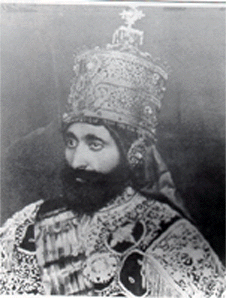 His Imperial Majesty Emperor Haile Selassie I, 1930
His Imperial Majesty Emperor Haile Selassie I, 1930
 BIRTH & ANCESTRY
BIRTH & ANCESTRY
Emperor Haile Selassie I was born on July 23,1894,as Lij Taffari Makonnen at Enjersa Goro, just outside
the city of Harrar. His parents were Ras Makonnen Wolde Michael, the governor of Harrar,
and his wife, Woizero Yeshimebet Ali AbaJiffar. Ras Makonnen was the son of Dejazmatch Wolde Michael Wolde Melekot,
a noble of Doba in northern Shewa. Ras Makonnen's paternal grandfather was Ato Wolde Melekot Yemane Kristos a Tigrean noble from Tembien who had moved to Shewa. Ras Makonnen's mother however was Woizero
Tenagnework Sahle Selassie, daughter of King Sahle Selassie of Shewa, sister of King
Haile Melekot of Shewa, and aunt to Emperor Menelik II of Ethiopia. Ras Makonnen was thus
the first cousin of Emperor Menelik II and a member of the Solomonic Dynasty. Woizero Yeshimebet his wife was the daughter of Dejazmatch
Ali AbaJiffar, an Oromo chieftan of Wollo, and his wife Woizero Welete Giorgis Yimeru, a Gurage and Amhara
woman once married to Ras Darge Sahle Selassie (Menelik II's uncle). Woizero Yeshimebet died before her son was
2 years old. Ras Makonnen had an elder son Yilma whom he did not aknowledge until later in
life (some say after Yilma saved his fathers life during the battle of Adowa). Dejazmatch
Yilma Makonnen was Emperor Haile Selassie's only sibling, and was the father of four children, sons
Kegnazmatch Sehalu Yilma, Kegnazmatch Asfaw Yilma and Dejazmatch Mengesha Yilma, and a daughter Her Imperial Highness Princess Yeshashework Yilma. Ras
Makonnen himself had several siblings however. His elder sister Ihite Mariam had a daughter Mazlekia,
who was married to Fitawrari Haile Selassie, and was the mother of Ras Imiru Haile Selassie,
who was to be the Emperor Haile Selassie's life long companion and close confidant. As Ras
Makonnen spent a great deal of time traveling on diplomatic business for Emperor Menelik, so he
entrusted the care of his son Taffari to Fitawrari Haile Selassie. Therefore, Taffari grew up with Imiru more as brothers rather than cousins. Lij Taffari also was cared for by his maternal grandmother Woizero (later Emahoi after taking vows and becoming a nun) Welete Giorgis, and his maternal aunt Woizero Mammit. The boys were given the traditional education given to the children of Ethiopia's aristocracy. They were taught by Orthodox priests, and could recite the psalms in Ge-ez by age six. They were ordained deacons and served as such at Harrar's St. Michael's Church. Later,
Ras Makonnen approached a French Catholic Capuchin monk residing in Harrar, Father Jaresseau to teach the
boys along western lines. The Catholic priest taught them French, geography, world history, philosophy and some
Latin as well. Over the next years, Taffari also picked up English, and German, as well as the
Ethiopian languages of Amharic, Tigrigna and Oromigna(called Galligna in those days) and became a
scholar in Ge-ez. After the death of his wife Woizero Yeshimebet, Ras Makonnen was prevailed upon by Empress Taitu to marry into her family. She arranged for him to marry her niece, Woizero Mentewab, a girl closer to the age of Lij Taffari and Lij Imiru than Ras Makonnen. Brought to Harrar, Woizero Mentewab briefly presided as lady of the household and step-mother to Lij Taffari, however less than a year later, Ras Makonnen sent the girl back to her aunt, the marriage having never been consumated. He believed it was unfair to the girl to marry her to a man of his comparatively advanced years. Empress Taitu took deep offense and never forgave the Ras. Lij Taffari however would hold the woman who was briefly his step-mother in high regard for the rest of her life.
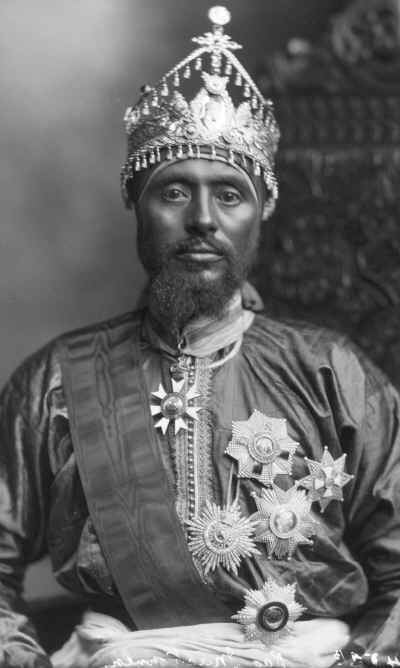 His Imperial Highness, Ras Makonnen Wolde Michael, Father of Emperor Haile Selassie I
His Imperial Highness, Ras Makonnen Wolde Michael, Father of Emperor Haile Selassie I
PATH TO THE THRONE
At the age of thirteen, Lij Taffari Makonnen was created a Dejazmatch by his father, and given
the district of Garra Muleta as his fief. Ras Makonnen also summoned all his officers and informed them that
it was his wish that his son Dejazmatch Taffari succeede him as governor of Harrar, and asked them all to
swear their loyalty to Taffari. Although Ras Makonnen may have tried to establish his wishes in such a manner, ultimate decisions as to the succession of the Harrar governorate belonged to his cousin Emperor Menelik II. When Ras Makonnen died suddenly in 1908, the situation in Ethiopia
was not what most had anticipated. The Ras died at Kulibi on his way to Addis Ababa from Harrar possibly of typhus. He was taken back to Harrar and buried at St. Michael's church there. Emperor Menelik was beside himself with grief upon hearing that Ras
Makonnen had dead. He had the huge funeral tent set up on the grounds of the Imperial Palace in the capital, and proclaimed
that he himself would be the chief mourner for Ras Makonnen in place of the two sons of his cousin. He summoned Dejazmatch Taffari, and Ras Makonnen's entourage from Harrar to Addis Ababa where Dejazmatch Yilma was already residing. Dejazmatch Taffari and the officers of Ras Makonnen
arrived in Addis Ababa, and they walked into the Emperor's presence weeping and carrying a large portrait of the
dead prince. Traditionaly, royalty in Ethiopia did not show emotion in public, so it stunned and moved the assembled courtiers when suddenly, Emperor Menelik rose up from his throne and embraced the portrait of his dead cousin, weeping and sobbing repeadedly, "Makonnen my son, Makonnen my brother! I have lost my right hand!" Menelik did not expect the younger Ras Makonnen to pre-decease him. Indeed it was often speculated that because Menelik had no sons of his own, he might name Makonnen his heir. This was not to be however.
Although Ras Makonnen had made clear that he had wanted Dejazmatch Taffari to succeede him as governor of Harrar, Menelik was not disposed to following through on that. Empress Taitu was especially opposed to Taffari inheriting Harrar, arguing that he was far too young. Instead, she argued for the apointment of the elder son of Ras Makonnen, Dejazmatch Yilma, who had been at the Imperial Court for several years, and was now appointed to succeed his father as governor.
The Empress also arranged for Yilma to marry her neice Woizero Aselefech. Dejazmatch Taffari was instead given the honorific governorship of Selale, and told to remain at court where he became a member of the Emperor's personal retinue. Empress Taitu may have also advised this course of action because she suspected that the young prince may have been unduly influenced by the Roman Catholic priests that had been teaching him in Harrar. She may have suspected that he might have accepted the Catholic faith because he held so many of the progressive views of his father associated with westerners and Catholics. She would soon be reassured that he was firmly Orthodox however as far as religion went. He was placed in the new school built in the
capital for young nobles, the Menelik II School. This situation continued until in 1910 when Dejazmatch Yilma also died. Dejazmatch Balcha Saffo (known as Abba Nega) was briefly appointed to the Harrar governorate, but proved to be extremely unpopular with the local officials who had long identified with Ras Makonnen and his sons. They appealed to Addis Ababa to have Dejazmatch Balcha removed. Empress Taitu, acting
on Menelik's behalf due to the Emperor's stroke, appointed Taffari to the governorship of Harrar. It was to be her last official act, as the very next day, the nobility led by Fitawrari Hapte Giorgis and Dejazmatch Gebre Selassie Baria Gabr, deposed her, and put power in the hands of the Lord Regent Ras Tessema Nadew. They limited the Empress to caring for the stricken Emperor. In 1913, Emperor Menelik II
died, and Lij Eyasu assended the throne, with Ras Tessema Nadew as his Regent. That same year, Ras Tessema also
died under mysterious circumstances, and Lij Eyasu took the reigns of government himself, although he refused to
be crowned as of yet. In 1916, Dejazmatch Taffari Makonnen was removed from Harar by Lij Eyasu, and appointed governor
of Kaffa. Dejazmatch Taffari was very resentful of the loss of what he considered his birthright. In addition Lij Eyasu, after taking
Harrar for himself, had moved into the governors palace there, and ordered that his niece, and Taffari's wife, Menen, be
evicted immediately. Lij Eyasu was informed that Woizero Menen was in the midst of giving birth, and could not possibly
be moved (she was giving birth to Prince Asfaw Wossen, later Emperor Amha Selassie). He resentfully agreed to allow
his niece to give birth, but ordered her to leave immediately afterwards. This embittered already poor relations between
Taffari and Eyasu. Not long after this, the nobles and ministers of the Empire began to openly express concern about the
erratic behavior of the heir, and his apparent sympathy for Islam. The diplomatic missions of the Entente Powers, concerned
about Lij Eyasu's pro-German leanings encouraged this dissension. Finally, the Nobility, led by Fitawrari Hapte Giorgis, became convinced that Lij Eyasu
had secretly converted to Islam, and following a two day meeting at Jan Meda in Addis Ababa (the Imperial Parade Ground),
the nobility convinced the reluctant Coptic Archbishop, Abune Mattiwos, to declare Lij Eyasu an apostate, and release them
from their oaths of loyalty to him. The nobles decided to swear fealty to the daughter of the late Emperor Menelik, and so
Empress Zewditu was proclaimed Elect of God, Conquering Lion of Judah, and Queen of Kings, at the feast of Maskal (Feast of the
Holy Cross' discovery by St. Helena)which fell on September 27,1916. Dejazmatch Taffari Makonnen was proclaimed Heir to the Throne, and Crown Prince with the title of Ras as a compromise to progressives who were feeling relegated from the action which was being led by the conservative forces. Ras Taffari soon afterwards assumed the title of Regent, and became the true ruler of the Empire.
 His Imperial Highness Ras Taffari Makonnen, Crown Prince and Regent of The Ethiopian Empire, 1917
His Imperial Highness Ras Taffari Makonnen, Crown Prince and Regent of The Ethiopian Empire, 1917
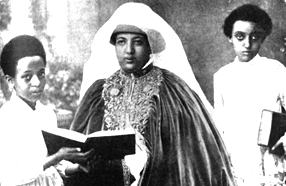 Her Imperial Highness Menen Asfaw, Crown Princess of Ethiopia.
Her Imperial Highness Menen Asfaw, Crown Princess of Ethiopia.
Ras Taffari Makonnen began to institute wide spread reforms in order to bring Ethiopia into the modern age. In order to qualify for membership in the League of Nations, the Regent proclaimed the end of slavery in 1923, and all slaves were declared free. A school was established in Addis Ababa for former slaves as well. The first newspapers were established to disseminate the progressive views of the Crown Prince and his supporters to the people in order to win support He also went on a tour of the Holy Land and the European capitals, being the
highest ranking member of the Imperial family to ever travel abroad. He visited Rome and was greeted by the new Prime Minister, Benito Mussolini, as well as by King Vittorio Emanuelle. The King of Italy invested the Crown Prince of Ethiopia with the Order of the Annunziata, which entitled him to be called a "cousin" of the King of Italy (Something that would be regarded with such irony only a few years later). He went on to Paris, Luxembourg (Where the
reigning Grand Duchess Charlotte gave birth to her heir Grand Duke Jean during his visit),Belgium,
the Netherlands and Britain in an official capacity and paid private visits to Sweden and Germany. He met the Pope as well, and received an honorary degree from Cambridge University.
In an effort to convince the nobility of the Empire that the path of modernization and progress was the best way to
guarantee Ethiopia's continued independence and future prosperity (as well as to keep a close eye on them), the Prince-Regent had brought with him to Europe
the leading nobles and aristocrats of his country. This exposure to the west with it's wealth, it's technology and it's military might as well as to it's many material advantages was instrumental in getting the nobility to relax their long time conservative opposition to the progressive trends of the Prince and his predecessors, Emperors Menelik II and
Tewodros II. The visit was very successful in that respect. However, he failed to convince France, Italy and Britain to cede Ethiopia a sea port in one of their colonies. The Ethiopian delegation caused quite a stir in Europe and aroused the interest
of many who were not aware of the only ancient independent state in Africa. Much comment was made on the impeccable aristocratic
manners and traditions of the delegation, and on the enlightened attitude of the Crown Prince. His desire to bring progress and education to his people was applauded in the European press. Among several anecdotes from this trip, is one involving Ras Hailu Tekle Haimanot of Gojjam. This Prince was one of the wealthiest men in the Ethiopian Empire. He was the son of a king, and a man who carried himself as such. When the Crown Prince and his entourage were received by King George V and Queen Mary at Buckingham Palace, Ras Hailu along with the other princes and nobles was introduced to the British King. King George in meeting Ras Hailu asked if His Highness could speak English. The interpreter said no. He asked if he could speak French or German, again the answer was no. King George, rather irritated told the interpreter to tell His Highness that he was an ignorant man. Ras Hailu listened quietly and asked the interpreter if His Majesty could speak Amharic. When told no, he asked him if His Majesty could speak Tigrigna or Guragigna, again he was told no. The prince then haughtily told the interpretter to tell the King that His Majesty was equally ignorant. King George burst out laughing and took a great liking to Ras Hailu, Prince of Gojjam. Ethiopia was said to be opening up to
the world.

His Imperial Highness Crown Prince Ras Tafari Makonnen, Regent of the Ethiopian Empire preparing to meet Pope Pius XI in audience, accompanied by the Vatican secretary of State, Ethiopian Princes and nobility, and with clergy and nobility of the Vatican state, 1923.
Upon his return, the Crown Prince was able to please the Empress with the news that the British government would be returning one of the crowns of Emperor Tewodros II that the Napier expedition had siezed and carried off from Magdala in 1867. He did have to face however the deepening hostility to his modernizing zeal on the part of the conservative camp led by Fitarwrari Hapte Giorgis (who had not accompanied him abroad) and the Archbishop Abune Mattiwos who was displeased with the delegations call on the Pope in Rome. They rigorously opposed his every move towards modernizing the administration of the Empire, raising objections, saying that the things the Prince wanted to do were "un-Ethiopian". Particularly, when told that slaves were to be freed, Fitawrari Hapte Giorgis is said to have sputtered with outrage "...so is my wife to carry water on her back from the springs herself????" With the deaths of these two powerful but elderly men, Ras Taffari was able to consolidate his power by co-opting much
of the Fitawrarris personal forces and staff into his own, and by postponing the appointment of a new Archbishop by entering into
negotiations with the Coptic Patriarchate of Alexandria over the posibility of having an Ethiopian appointed to the post for the first time.
The reluctance of the Patriarch to agree to this resulted in the Ethiopian born Echege (Abbot of Debre Libanos Monastery) being the highest
ranking cleric in Ethiopia, and he being much more in sympathy with the regent than the Archbishop had been, it was in the interests of the Prince
to let things remain as they were and let the negotiations with the Holy See of St. Mark drag on. The power of the conservatives was thus greatly reduced. The Empress, although a staunch traditionalist was
increasingly devoting her time and energies towards prayer, fasting, and church building. She was therefore never an effective leader for the forces of conservatism. Part of the reason for this behavior may have been a deep sense of guilt that she bore for having defied her father's will and replaced his designated heir on the throne, and also because of her deep sorrow at being forcefully separated from her husband. These events may have put her in a position of helplessness, and at the mercy of her nobles. After a series of plots and counter plots, an attempt was made to arrest the Prince-Regent at the Imperial
Palace by conservative elements in the cabinet, possibly with the Empresses knowledge and agreement. However, the Crown Prince's wife got wind of the plot, and was able to alert him as well as send a force of his guards to the palace to liberate him. The Empress claimed ignorance of the plot, although it had been carried out in her name. Progressives and modernizers in the nobility and the army held an unprecedented demonstation in support of Ras Taffari on the grounds of the palace. In order to appease the angry progressives who rallied to the Crown Prince, the Empress agreed to crown him king. In November of 1928, Empress Zewditu of Ethiopia crowned Taffari Makonnen as
King and Heir to the Throne of Ethiopia. It was an unusual arangment as the King would remain in the capital with the Empress, and that no territory
such as Wollo or Gondar was given him with the title. It was assumed that he was king of all Ethiopia, an unprecedented situation. His coronation as Nigus was regarded as a dress rehersal of sorts for his eventual coronation as Niguse Negest (Emperor). He would later see
to it that no one else would ever be crowned king once he became Emperor.
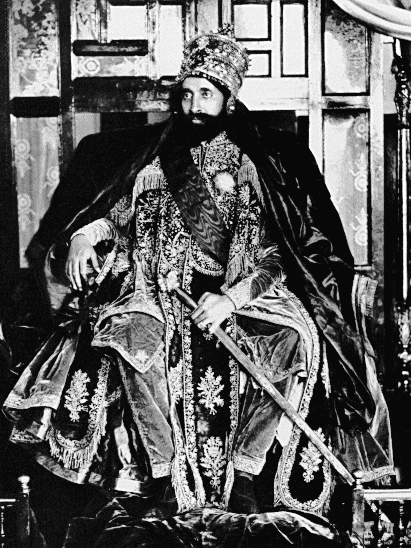 Taffari Makonnen, as King and Heir to the Throne, 1928
Taffari Makonnen, as King and Heir to the Throne, 1928
With the eventuallity of his becoming emperor all the more likely now, the new king
began to accelerate the process of getting an Archbishop from Alexandria. Although the Copts remained staunch in refusing to name an Ethiopian to the post, the
Ethiopians were able to get the Patriarch to appoint 4 Ethiopian born suffrugan bishops to serve under the Egyptian Archbishop. The new Egyptian born Archbishop Kyrilos, and
the Ethiopian born Bishops Petros, Abraham, Markos and Lukas were all consicrated in Alexandria and arrived in Ethiopia soon afterwards. The Ethiopian Church was jubilant to have
so many bishops at once, as well as 4 native born bishops. A year later, upon the occasion of the visit of the Coptic Patriarch of Alexandria to Ethiopia, he consicrated the Echege of Debre Libanos, as the fifth Ethiopian born Bishop with the name Sauiros.
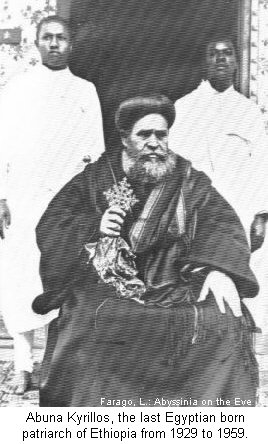 Abune Kyrilos, last Egyptian born Archbishop of the Ethiopian Orthodox Church (the caption erroneously refers to him as Patriarch)
Abune Kyrilos, last Egyptian born Archbishop of the Ethiopian Orthodox Church (the caption erroneously refers to him as Patriarch)
 Dejazmatch Balcha Saffo, known as "Balcha Abba Nefso"
Dejazmatch Balcha Saffo, known as "Balcha Abba Nefso"
Soon after becoming king in 1928, Nigus Taffari recieved yet another challenge from
the forces of conservatism. Dejazmatch Balcha Saffo, known popularly by his horse name of "Abba Nefso", an Oromo unich who had been raised by Emperor Menelik and placed in several powerful posts by that Emperor. He had briefly succeeded Dejazmatch Yilma Makonnen as governor of Harrar, but upon his replacement by the then Dejazmatch Taffari in 1910, he had been appointed Governor of the wealthy gold, ivory and coffee producing province of Sidamo. Now he arrived in Addis Ababa from Sidamo with a very large number of well armed men. He had repeatedly refused the summons of the new King to come to the Capital, and only obeyed now because he had recieced a summons from the Empress. Dejazmatch Balcha and his army encamped at Nifas Silk, just outside
the city, and the presence of Balcha's large Army was regarded as being a direct challenge to the king, in support of the Empress and the conservatives she supported. On the second
evening after his arrival, Dejazmatch Balcha and his leading officers were invited by King Taffari to come to the Imperial Palace for dinner. They arrived to find a fine feast prepared for them, and much to drink. As the evening wore on, and Balcha's officers grew more and more intoxicated, they also grew more and more insulting
to the king and his supporters as they sang songs as was customary. When the Dejazmatch and his followers finally returned to Nifas Silk, they were stunned to find that
his entire army had vanished. While they had been eating and drinking at the palace, Ras Kassa Hailu and several other officials had arrived at Nifas Silk with a bag of
Silver Maria Theresa Thallers, and another bag of whips. They announced to Balcha's army that a new governor, Ras Birru, had been appointed for Sidamo and that they were to report to him at once.
They were instructed to immediately accept payment in the silver coins, surrender their weapons and go home. The bag of whips was left in clear view to show what would happen to
anyone who did not obey. Within a short time, the soldiers had surrendered their weapons, recieved their payment and were headed back to their farms and families in the
south. When Dejazmatch Balcha realized what had happened he fled to the Raguel Church on Mt. Entoto and rang the bell, a traditional plea for royal mercy in Ethiopia that
monarchs were required to honor. The King confined Balcha to a monastery, but did not punish him further.
The country was abuzz with the many changes that were taking place. Bale was set up as a model
province and was ruled along western lines with direct rule from the Central government, as an example to the nation. The armies of the various nobles and princes were being
increasingly consolidated into a central military force with loyalty to the central government and not to regional leaders. Taxation was being uniformized accross the land
and it's collection handed over to officials appointed by Addis Ababa rather than by the regional rulers. This cut into the income of the regional aristocracy and caused great resentment. The most
resentful was clearly Ras Gugsa Wele who had much to be angry about. Although he had been made governor of Beghemidir, he fealt greatly slighted by the Shewans, and by King
Taffari in particular. The Shewans and Tigreans had been responsible for the removal from state responsibility of his aunt Empress Taitu. They had later conspired to remove
Lij Eyasu and place his own wife on the throne on the condition that he her husband separate from her, and sent him to far off Gondar to make sure his influence on the Empress would be minimal. His resentment against Addis Ababa and the King increased
as time went by, and he recieved encouragement from the Italians in Eritrea. In 1929 he gathered together a huge army of Beghemidir, Simien, and Yeju loyalists of his family, and marched on Shewa. The Empress pleaded with her husband repeatedly to no avail. Her final letters to him showed that she had become quite embittered by his refusal to listen to her pleas. The government ordered an Army north to
meet him and do battle, and the two forces met at Anchiem plain. Before the battle began, the government engaged in a first for Ethiopia, the use of airoplanes in battle. Two flights
took place. The first flight was used to drop leaflets on Ras Gugsa's army which bore messages from the Archbishop Kyrilos excommunicating anyone who was found to have fought against
the government, and another that bore letters from the Empress (reluctantly written) and the King-Regent that declaired Ras Gugsa a rebel. This psychological warfare worked on some of Ras Gugsa's forces
who then began to desert in significant numbers. The second flight then took place in which a bomb was dropped on Ras Gugsas army and caused panic, and the bitter battle of Anchiem began. By the end of the day, Ras Gugsa was dead and
his army crushed. Quiet celebration of this victory had barely begun in Addis Ababa the next day when suddenly the capital was plunged into deep mourning with the death of Empress Zewditu herself. Zewditu's death was a shock to her subjects. The population was deeply saddened as Zewditu was hugely popular, arousing much sympathy with her piety and her devotion to her late father.
It is unclear if Empress Zewditu was actually told that her husband was dead, and if this played a role in her demise. There are those who maintain that the Empress was poisoned as soon as
news of her husbands defeat was certain, by radical modernist elements in the Palace. It had however been a palace secret that the Empress had long suffered from diabeties, and that in addition to western medicine, she also took traditional
folk treatments, and visited shrines to bathe in holy water and holy springs in hopes of a cure. Members of the diplomatic corps reported to their home governments that the Empress had been taken early that
morning to be emmersed in a container of frigid holy water for a cure, and that she had promptly gone into shock and died. They reported that she had not been told of her husbands death. Other more romantic rumors reported
that the Empress had fainted in sorrow upon hearing of the death of her husband, and had then died of a broken heart. Her Swiss doctor would report years later that her cause of death was diabeties, and it is this that
is stated in Emperor Haile Selassie's autobiography, and in a book by General Virgin, a Swedish military advisor. Nevertheless, this event marked the end of the conservative feudal era in
Ethiopia, and the beginging of the new centralized beaurocratic Empire. The day after the death of Empress Zewditu, Nigus Taffari Makonnen was proclaimed Emperor Haile Selassie I, Elect of God,
Conquering Lion of Judah+
, King of Kings of Ethiopia. His wife became Empress Menen of Ethiopia, and his children all assumed the titles of Prince and Princess.
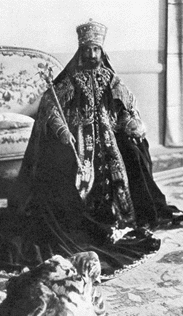 Emperor Haile Selassie I, Conquering Lion of Judah, Elect of God, King of Kings of Ethiopia in full
Coronation Regalia
Emperor Haile Selassie I, Conquering Lion of Judah, Elect of God, King of Kings of Ethiopia in full
Coronation Regalia
On November 1st, 1930, the new Emperor of Ethiopia paid his respects to his illustrous predicesor, by erecting a equistrian statue of Emperor Menelik II infront of the Cathedral of St. George.
Addis Ababa's streets had been newly repaved, electrical lights put up and unsightly slums cleaned up for the pagentry that would follow the next day. On November 2nd, 1930, Haile Sellasie I
was crowned Emperor of Ethiopia by the Coptic Archbishop, Abune Kyrillos at the Cathedral of St. George. His wife was also crowned as Empress, and Crown Prince Asfaw Wossen anointed as Heir to
the Throne. The coronation was the most splendid yet in Ethiopia. On the evening of November 1st, the Emperor and Empress were driven to the Cathedral in an open car as footmen riding behind them held red velvet umbrellas, heavily
embroidered in gold, over their heads. After an all night vigil at the Cathedral, the foreign guests arrived to witness the anointing and crowning of the Imperial couple and the anointing of the crown prince. Around the outdoor dias were four large live lions, chained to the platform on which the Emperor sat with gold chains. The Emperor and Empress were crowned outdoors infront of the Cathedral and enthroned there, as canons boomed a 100 gun salute, church bells rang, women ulultated and men cheered. The Imperial family, under a large portable gold encrusted canopy of red velvet, the upper nobility and clergy along with the foreign delegations then entered the cathedral to hear mass. The coronation was witnessed by royalty and important dignitaries from around the world. Representing the British Empire was H.R.H. Prince Henry, Duke of Gloucester, son of King George V,
brother the future Kings Edward VIII and George VI, and uncle to Queen Elizabeth II. Representing Italy was H.R.H. Prince Eugenio Di Savoia, Duke of Udine, cousin of the King of Italy. France was represented by
Marshal Franchet D'Esperry. The King of Belgium was represented by Monseiur Gerard, the King of Sweden by Baron Dabells, the Queen of the Netherlands by Mr. Unhar Hersmadd, the Emperor of Japan by Baron Ezbur, the King of Egypt by Tewfik Nessim Pasha, the Greek government by Count Metaxis, the government of Turkey by Muhitin Pasha, the government of Poland by Count David Bazaki, the President of Germany by Baron Balthaussen, and the President of the United States by Mr. Jacobi. The international press was also present, a first for Ethiopian coronations. Following the church ceremonies, the Emperor and Empress boarded the former Imperial Coach of Germany, which had been purchased from the German government earlier. Thousands of Ethiopian subjects
and nobles lined the streets to the palace and witnessed the procession, the last coronation the country would see.
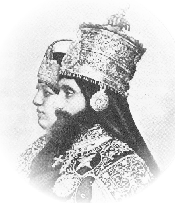 The Official Coronation Portrait of Their Imperial Majesties, Emperor Haile Selassie and Empress Menen of Ethiopia.
The Official Coronation Portrait of Their Imperial Majesties, Emperor Haile Selassie and Empress Menen of Ethiopia.
National Geographic took photographs of the Emperor in his coronation robes and covered the events in their next issue. The pagents did not go off without a glitch however. During welcoming ceremonies for the foreign delegations there was one significant event that caused minor disruption. As Crown Prince in 1923, the Emperor had visited Jerusalem. While there, the Armenian Patriarch and Catholicos of Jerusalem had met him, and told him of the plight of the large number of Armenian orphans being raised by the Patriarchate, and the financial dificulty this had placed on the patriarchate. These children were among the survivors of the huge massacres of Armenians by the Turks a few years earlier. The then Crown Prince had decided to help the Armenian Patriarch by taking some of these orphans to Ethiopia to raise them in a country that shared the Oriental Orthodox heritage of their dead parents. These Armenian youths had formed a marching band in Ethiopia that played at many public events, and at the Palace as well for Imperial occasions of state. During the welcoming ceremonies before the coronation, they would play the national anthem of which ever delegation was arriving at the train station. When the Turkish delegation arrived, the Armenian youths staunchly refused to play the Turkish anthem causing the Emperor to be very embarrassed and quite angry. The Emperor decided to put the matter before the senior princes and nobles in council to decide how to punish the Armenians for disobeying the monarch. When the council demanded an explanation from the band, the Armenians tearfully replied that it was against their conscience to honor those who had butchered their fathers and mothers. Much moved, the council agreed that it was too much to expect the Armenians to honor the representative of Turkey, so they recomended that they not be punished. The Emperor agreed and the Armenians were allowed to disobey the Emperor and refuse to play the Turkish National Anthem as it was in violation of the commandment "Honor your Father and Mother". Among the guests at the coronation was the novelist Evlyn Waugh who would one day be a major defender and apologist for the fascists and Mussolini's invasion and occupation of Ethiopia.
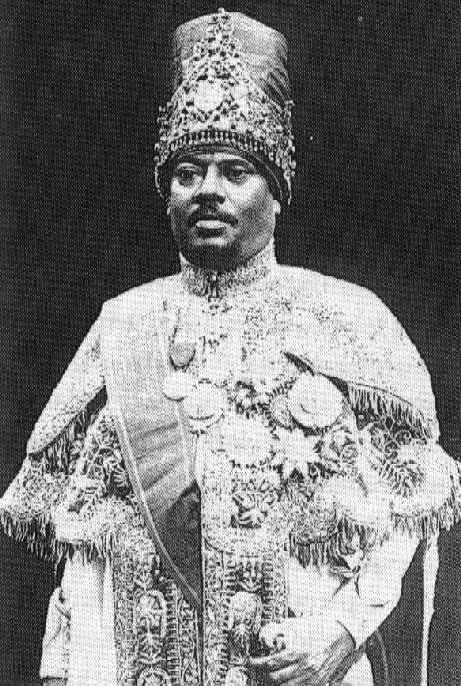 Ras Birru Wolde Gabriel at the time of Emperor Haile Selassie's coronoation. The Ras was often rumored to be the illegitimate son of Emperor Menelik II Ras Birru Wolde Gabriel at the time of Emperor Haile Selassie's coronoation. The Ras was often rumored to be the illegitimate son of Emperor Menelik II
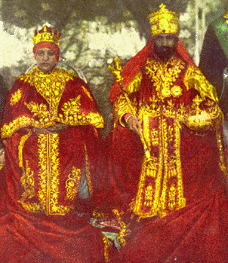 Emperor Haile Selassie I and Empress Menen of Ethiopia at their Coronation, November 2nd, 1930
Emperor Haile Selassie I and Empress Menen of Ethiopia at their Coronation, November 2nd, 1930
Emperor Haile Selassie began an agressive programme of modernization and centralization of the structure of the state. He ordered the drafting of the first written constitution for the Empire, which
was completed and promulgated in 1931. The First Imperial Constitution, which borrowed heavily from the Meiji Constitution of Japan, provided for a Parliament for the first time in Ethiopian History.
The Parliament was composed of two houses, a House of Deputies (lower house) and an Imperial Senate (upper house). The Senate was comprised of High Nobles, and important personages who were appointed to their seats
by the Emperor. The lower house was made up of land owners, and was also filled by appointment of the Emperor. Although the structure of this new constitution maintained the absolute power of the monarhcy, it did set
down the rights of the people. As was traditional, the Supreme Court of Ethiopia remained the Emperor's Chilot, where the Emperor heard the cases himself and passed down the final verdict. Every subject
had the right to appeal to this court and to be heard. The ministries were staffed with men who shared the Emperors progressive views, and advisors were employed from abroad to help them in their work.
The cabinet of ministers, established by Menelik II was expanded, and under the constitution it had an advisory role to the monarch, as well as running the day to day affairs of state. Emperor Haile Selassie
being the type of person he was, however, was not one to let others do the work of state. He was very active early in his reign with the most minute details of government. However, as he grew older, and
the government grew in size and in function, he began to have less and less of a role, and simply excersized his final approval/veto of policies formulated and excecuted by the increasing number of technocrats.
The Emperor had no Prime Minister, but the Tsehafi Te-ezaz, a traditional title that had been converted into the Minister of the Pen in the modern cabinet, was the most senior of the ministers. After 1961, however,
the Emperor decided to appoint a Prime Minister to take on more of the Policy formulation role in government. Early in his reign though, there were not enough educated Ethiopians to take on the responsibilities this would entail. The Emperor also used the restructuring of the government to severly curtail the powers of the aristocracy and the regional princely and noble families. The 1931 constitution limited the succession to the Imperial Throne not only to the House of Solomon, but within the House, to direct decendants of Emperor Haile Selassie. This limit on the Imperial succession caused considerable unhappiness among the Princes of the Imperial blood who were expected to sign away their potential claims to the throne by endorsing the constitution, particularly Ras Hailu of Gojjam and the princes of Tigrai, Ras Gugsa and Ras Seyoum. Ras Kassa Hailu himself, a firm ally of the Emperor in most matters, and a man who had refused to be considered for the throne himself, was not the least bit pleased that his decendents should be excluded in this manner. He pled illness and was not present for the signing of the constitution, and did not sign it. The Emperor encouraged the spread of modern education, and sponsored many young Ethiopians to go to Europe to study. He built the Haile Selassie I Hospital (known today as the Yekatit 22), and several
schools. A modern military was being developed with the aid of European advisors. The Swedes trained his Imperial Guard, and the Belgians his Imperial Army. He built the Amsale Guenet Palace, and housed the visiting Duke of Abruzzi there, and then recieved the Crown Prince of Sweden Gustav Adolph and his wife for a state visit and housed them in the newly built Guenete Leul Palace, both built on the site of his fathers old Addis Ababa house. After the visits, the Emperor and Empress moved in to the new Guenete Leul palace themselves, and it together with the Amsale Guenet became known as the Little Guibi (the Menelik or Imperial Palace being the Great Guibi). Ethiopia sought to emulate Japan in it's development strategies, something that the colonial powers in the region were not very pleased about.
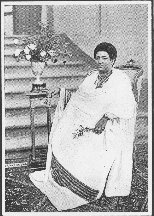 Empress Menen (possibly shortly before the birth of H.I.H. Prince Sahle Selassie)
Empress Menen (possibly shortly before the birth of H.I.H. Prince Sahle Selassie)
 Ras Hailu Tekle Haimanot, Prince of Gojjam
Ras Hailu Tekle Haimanot, Prince of Gojjam
It was during this time, late 1931, that Lij Eyasu escaped from his detention at Selale. He was hunted down and captured, and re-imprisoned, this time in much less comfortable circumstances at Gara Muleta in Harar. Eyasuism would
continue to be a thorn in the side of the government. Lij Eyasu himself would remain a prisoner, but among the people of Wollo and among various elements in the nobility, there were strong feelings that he was the true and legitimate heir to Menelik II, and this belief would persist for a long time. Upon the recapture of Lij Eyasu, it was found that he had been aided by his former father-in-law, the Prince of Gojjam, Leul Ras Hailu Tekle Haimanot, in concert with the Italian colonial authorities in Eritrea. The Gojjami prince, who previously had been convicted of conspiracy to murder someone, was now sentenced to life imprisonment. Behind his plot to restore his ex-son-in-law was Hailu's deep resentment at not having been made King of Gojjam in succession to his late father, Tekle Haimanot. Ras Hailu was a fabulously wealthy man, he may have well been the richest man in the Empire. He taxed Gojjam brutally, and he owned lavish homes both at his seat in Gojjam at Debre Markos, and in the capital. His relations with his his brothers, Ras Bezabeh, and
Dejazmatch Bellew were not warm, and all three brothers at various times had quarelled with their father and sought the protection of Menelik. Menelik II always partial to the King of Gojjam, never tried to undermine him by using his sons against him, but rather counseled the sons to honor their father. Tekle Haimanot was aware of this, and appreciated it. Upon Tekle Haimanot's death, his widow Laquech Gebre Medhin, sister of Emperor Tekle Giorgis III, wanted to rule Gojjam as successor to her husband as did both Bezabih and Bellew who were at court with Menelik. Her argument was that her stepsons had behaved badly toward their father and so she should be considered his heir. Bezabih had married Lij Eyasu's sister Zenebework, but it was Seyoum ( who changed his name to Hailu) who ended up with the bulk of Gojjam. Now though, Emperor Haile Selassie was determined not to create anymore vassal kings within the Empire following Menelik's example. Menelik had chosen to recognize Tekle Haimanot as king of Gojjam because that title had been granted by Yohannis IV, but he didn't create any
Kings elsewhere as he could have. Lij Eyasu had created his father King of Wollo, and Zewditu had made her cousin Wolde Giorgis King of Gondar, but the new Emperor was having none of that. The Tigrean and Gojjami royals were created "Leul" or Prince, their wives granted the title of "Lielt" or Princess. Thus Rases Seyoum Mengesha and Gugsa Araya (succeeded by Dejazmatch Haile Selassie Gugsa) in Tigrai, Hailu, Bezabih, and Bellew (succeeded by Hailu Bellew) in Gojjam, and Kassa Hailu, and Imiru Haile Selassie in Shewa, made up a tier of "Princes of the Blood". They were royals with Solomonic blood who surrounded the throne of Haile Selassie, but knew that they could never hope to be made kings in his reign. Ras Hailu was resentful, and his aid to Lij Eyasu was probably in reaction to this. With his imprisonment though, The Emperor replaced him with Ras Imiru, his own cousin, and sent representatives of the central government to take over Hailu's property and the entire province of Gojjam bringing under the direct rule of the central government and ending the reign of the Gojjam
branch of the dynasty in the province. Ras Hailu's nephew, Ras Hailu Bellew would briefly govern Gojjam in the 1950's, and would be the last member of the Gojjam branch of the dynasty to govern it.
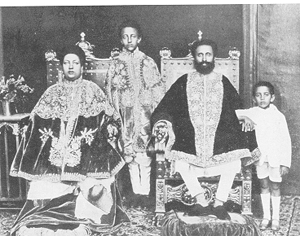
From Left to Right, Her Imperial Majesty Empress Menen,His Imperial Higness
Crown Prince Asfaw Wossen, His Imperial Majesty Emperor Haile Selassie, His Imperial Highness
Prince Makonnen Duke of Harrar, 1931
The Emperor continued with his modernizing zeal. Foriegn advisors were appointed to assist in advising and helping to set up a modern administration and beurocracy in the various ministries. The cadre of young educated people known as the "Young Ethiopians" made up a new domestic intelegencia which was rooted in progressive and modernist philosopy, and were relied on by the Emperor to carry out his plans for the Empire. They were eager and willing to work hard towards this goal. The Emperor continued to promote men of humble background to positions of the highest responsibility at the expence of the traditional nobility. The commoners, he believed, would be more directly loyal to him because they would owe him their education and high station completely, and be more likely to act in his interests. The old nobility was too conservative, and too ambitious with their own family interests and personal ambitions to promote. The aristocracy was increasingly resentful of the commoners that the Emperor seemed to favor, and they campaigned for him to return to appointing people from the noble classes to powerful posts. The Emperor decided to balance one group against the other by creating the Crown Council. The Cabinet of Ministers would eventually be dominated by commoners with a few nobles here and there, while the Crown Council would be dominated by the Aristocracy with a few commoners included. He hoped this would create a balance of interests. It was into this situation that the country would spiral into the Ethio-Italian conflict of 1936, and the prelude to World War II.

Her Imperial Majesty Empress Menen, 1930
Her Imperial Majesty Empress Menen was born in Wollo in 1889. She was the daughter of Jantirar Asfaw of Ambassel, and his wife, Woizero Sehin Michael. Woizero Sehin was the daughter of King Michael of Wollo and half sister of Lij Eyasu. Through King Michael, Empress Menen could trace her ancestry back to Emperor Fasiledes and also to the Prophet Mohammed. Empress Menen had been married three times prior to her marriage to Emperor Haile Selassie. Her husband immediately before the Emperor had been Ras Leulseged Atnafseged. From her first husband Empress Menen had two children, Woizero Belainesh Ali, and Jantirar Asfaw Ali. From her second marriage, she had two more children, Jantirar Gebre Igziabiher Amede and Woizero Desta Amede. She had no children from her brief marriage to Ras Leulseged. The Empress thus had ten children altogether and the Emperor therefore had 4 step-children. Empress Menen married Emperor Haile Selassie on July 30th 1910, while he was still Dejazmatch Taffari Makonnen of Harrar. Unlike her previous marriages, this one was a church wedding with a communion service, thus the only one of her marriages recognized by the Orthodox Church. Lij Eyasu ordered his niece to marry his maternal cousin, and involved Taffari's cousin Dejazmatch Imiru in escorting Woizero Menen to Harrar after he ordered her separation from Ras Leulseged. He may have promoted the match after the couple first met at his home in Addis Ababa and were smitten, and he realized the political advantages to him. Whatever one believes, what is certain is that their marriage proved very successful and long lasting. Theirs would prove to be a remarkable personal and political partnership. No one could claim to having been more influential with the Emperor than Empress Menen. The Emperor and Empress celebrated their golden wedding aniversary in 1960. Her Imperial Majesty died in 1961 after 51 years of marriage, at the age of 71. She had been Empress of Ethiopia for 32 years at the time of her death. She was buried at Holy Trinity Cathedral in Addis Ababa.
History of Emperor Haile Selassie Continued in Part 2
Click Here to Continue with Part II of History and Pictures
|
 Emperor Haile Selassie I (Part 1)
Emperor Haile Selassie I (Part 1)


 Emperor Haile Selassie I (Part 1)
Emperor Haile Selassie I (Part 1)

